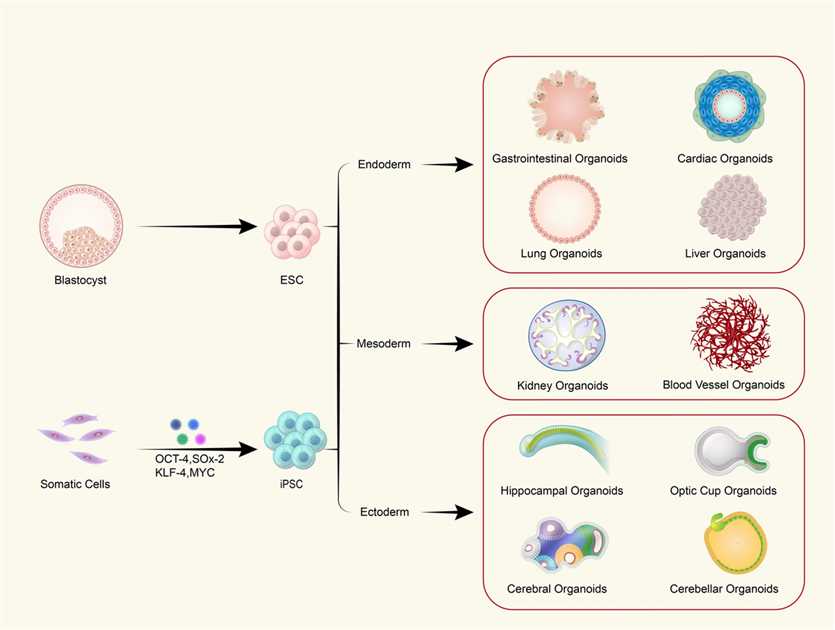Organoid
More and more researchers tend to use in vitro models for drug screening and evaluation. In addition to avoiding the ethical issues involved in animal experiments, shortening the research cycle, and reducing costs, it is an extremely important part of drug development to construct an appropriate in vitro model that reflects the in vivo environment as accurately as possible and to evaluate pharmacodynamics and pharmacokinetics on this basis. With more than a decade of experience in drug development, Creative Biolabs has been tracking the most cutting-edge technological innovations and creatively applying them to their drug development platforms, thereby contributing to the highest quality and reliable research services for our clients. The organoid is one of the significant tools for us to provide in vitro pharmacology and safety evaluation.
Organoid
Organoids are a three-dimensional "micro-organ model" that is prepared by self-organization of different types of stem cells and can mimic the structure and function of native organs. Compared with the traditional two-dimensional culture model, the organoids can represent the physiological processes of the whole organism, having the advantages of closer to the physiological cell composition and behavior, more stable genome, more suitable for transfection and high-throughput screening. Compared with animal models, the operation of organoid models is not only simpler, but they also can be used to study the mechanisms of disease occurrence and development.
In addition to adult stem cells, pluripotent stem cells, induced stem cells, and embryonic stem cells can also use their ability to self-renew and differentiate to produce organoids. To date, three major cell lineages have been developed into organoid culture systems that model tissue structures. Although different tissues require specific culture methods, in general, the preparation of organoids is to embed appropriate pluripotent stem cells or progenitor cells of specific tissues in appropriate basement membrane matrix or other extracellular matrix, and the cell culture medium used should contain specific growth factors that enable the medium to mimic the in vivo signals required to maintain a population of stem cells. Under this growth condition, the embedded cells proliferate and self-organize into a 3D-like organ structure and can be indefinitely passaged and maintained in many systems. In addition, these cultures showed a high degree of genetic stability during the passage. Up to now, organ-like cultures have been used in a variety of tissues including the intestine, liver, pancreas, kidney, prostate, lung, and brain.
 CC BY 4.0, https://commons.wikimedia.org/wiki/File:41392_2022_1024_Fig1_HTML.webp)" />Fig.1 Schematic depiction of different approaches for organoid generation.1
CC BY 4.0, https://commons.wikimedia.org/wiki/File:41392_2022_1024_Fig1_HTML.webp)" />Fig.1 Schematic depiction of different approaches for organoid generation.1
Applications of Organoid
As an emerging and powerful tool, organoid techniques can be used in a wide range of research, including developmental biology, disease pathology, cell biology, regeneration mechanisms, precision medicine, and drug toxicity and pharmacodynamic tests. Especially in the screening of anticancer drugs, the organoid model is gradually playing an increasingly important role. In the study of tumor ecological dependence, studies on different grades of colorectal cancer organoids show that the dependence on ecological factors is gradually reduced during the transition from normal tissues to adenomas to cancers. Factor dependence is primarily related to the genetic makeup of the tumor. Therefore, it can be said that organoids are a means to link tumor-related genomic data with tumor biology, providing a research basis for drug screening and personalized treatment.
Adverse drug reactions, especially organ toxicity, are the main cause of drug development failure and withdrawal after marketing. Currently, common cell screening and animal model screening often fail to accurately predict adverse events in humans. Renal and liver toxicity is the most common organ toxicity, and artificially prepared kidney and liver organoids provide a more accurate means of predicting toxicity, with kidney organoid proven to be able to explain nephrotoxicity caused by cisplatin and gentamicin. The advantages of organoids in adverse reactions research are also reflected in the reproducibility of genetic stability and high-throughput screening.
Table 1. Some organoid models that Creative Biolabs provides.
| Cancer Organoids | ||
| Stomach cancer | Liver cancer | Pancreatic cancer |
| Intestinal cancer | Breast cancer | Bladder cancer |
| Prostate cancer | Thyroid cancer | Ovarian cancer |
| Brain cancer | Lung cancer | |
| Other Organoids (from normal tissue) | ||
| Oesophagus | Stomach | Small intestine |
| Colon/rectum | Pancreas | Liver |
| Biliary |
Patient Derived Organoid
There are two types of commonly used tumor organoid construction techniques, one is produced by induced pluripotent stem cells (iPSCs), and the other is directly derived from tumor tissue. The success of the construction of tumor-like organoids derived from iPSCs depends largely on the type of tumor, and the operation is more complicated, resulting in lower construction efficiency. In addition, tumor-like organoids obtained by differentiation of iPSCs also lose the complexity of the tumor microenvironment. Therefore, it is the development trend of tumor-like organoids research directly through tumor tissue culture or stem cell differentiation, supplemented by cytokines and tumor stroma.
Services based on Our advanced Organoid Model
- Drug efficacy testing
- Pharmacokinetic assessment
- In vitro susceptibility test
- Drug toxicity testing
- Anticancer drug discovery
- Other customized drug evaluations based on organoid models
The development of drugs, work in the future. Creative Biolabs will be able to efficiently complete every step of drug development with our experienced professionals and rigorous attitude.
Reference
- From Wikipedia: By Xiao-Yan Tang, Shanshan Wu, Da Wang, Chu Chu, Yuan Hong, Mengdan Tao, Hao Hu, Min Xu, Xing Guo & Yan Liu. Under Open Access license CC BY 4.0, without modification, https://commons.wikimedia.org/wiki/File:41392_2022_1024_Fig1_HTML.webp.
For Research Use Only.
